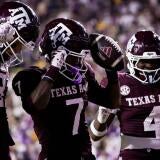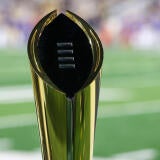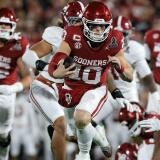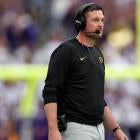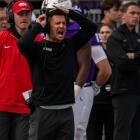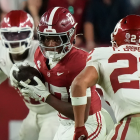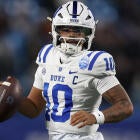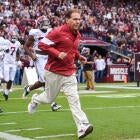The Monday After: Oregon's fourth-down decisions aren't all wrong, but failures are magnified in big games
Ducks coach Dan Lanning will be second-guessed after Oregon went 0 for 3 on fourth down in Saturday's loss to Washington

College football, like most sports, is a results-based business. The reason for this is that results are easier to judge. Wins are good. Losses are bad. Ties are confusing, so we got rid of them. It's all nice and straightforward and allows us to come to a quick conclusion about a team or a decision before moving on to the next one.
So when Oregon coach Dan Lanning decides to take some "risks" on fourth down and they don't work out, we can all decide he was wrong to do so, and Lanning can then take the blame for his team losing a game, like he did after Oregon was 0 for 3 on fourth down in its 36-33 loss to Washington on Saturday
"We got to win in the fourth quarter," Lanning told reporters crammed into an interview room. "I think we did some things well there at the end, but you're talking about being a third and one with an opportunity to get a yard and really up in, you know, potential victory situation and getting that tough yard gotta find a way to get that tough yard. Making sure we have the right call dialed up to be able to execute that, but we're close. We're right there. And that's something that is 100% my responsibility, we gotta get it accomplished. But we have the guys in that room to accomplish that."
Was Lanning wrong? Were the decisions to go for it on fourth down detrimental to his team's chances to win, or was it not executing the plan that hurt?
The biggest problem with the decisions was that they didn't work, but Lanning and the Ducks have made the same decisions many times before, and often they have been successful. The problem is that when they work during a 42-6 blowout win over Colorado (Oregon went for it four times on fourth down in that game and converted three times) or in a 55-10 blowout win over Hawaii, nobody remembers or cares because they weren't watching or "it didn't matter" because they were blowout wins. We ignore that converting them contributed quite a bit to the blowouts.
Unfortunately for Lanning, they haven't worked in Oregon's biggest games - the ones the world is watching. The Ducks failed on a fourth and one in their own territory during the fourth quarter against Washington last season in a tie game. Washington got the ball back and kicked the game-winning field goal. Against Oregon State, the Ducks went for it on fourth and one at their own 29 and were stopped by the Beavers, who then scored a touchdown that won the game.
Oregon was 8 for 10 on fourth down coming into the game and is 28 for 45 (64.4%) since Lanning took the job. It's part of the team's aggressive identity, and it's worked out well for them. Looking at Oregon's fourth-down decisions from an EPA (expected points added) perspective, it's obvious.
| Team | 4th Down Decisions | 4th Down EPA | EPA per Decision |
|---|---|---|---|
1. Washington | 29 | 8.1 | 0.28 |
2. Oregon | 33 | 7.8 | 0.24 |
3. Texas Tech | 59 | 13.5 | 0.23 |
4. Michigan | 32 | 7.2 | 0.23 |
5. UAB | 50 | 11.1 | 0.22 |
6. Penn State | 42 | 9.0 | 0.21 |
7. Arizona | 44 | 9.2 | 0.21 |
8. Texas | 45 | 9.2 | 0.20 |
49 | 9.2 | 0.19 | |
10. Oregon State | 43 | 7.9 | 0.18 |
This chart shows the EPA of a team's fourth-down decisions (punt, go, kick) based on the decision, not the result. It takes the perspective that you never completely control the outcomes, only your decisions. You know, the reality of life. As you can see, both Washington and Oregon have benefitted from their aggressive nature on fourth downs (though they benefit more from being good enough on offense to avoid having to make them far more often than other teams).
What about the EPA from Week 7? Well, based on the headlines I've seen on stories written about the game, you may want to sit down before you continue reading.
Team in Week 7 | 4th Down Decisions | 4th Down EPA | EPA per Decision |
|---|---|---|---|
1. Texas Tech | 9 | 4.2 | 0.47 |
2. Liberty | 6 | 2.6 | 0.43 |
3. Penn State | 2 | 0.8 | 0.40 |
4. UAB | 8 | 2.2 | 0.27 |
5. Oregon | 6 | 1.5 | 0.26 |
If you remove the results (hard to do, I know!), Oregon did more to help its team win the game with its fourth-down decisions than Washington (the Huskies added 1.2 points, and their 0.20 per decision ranked 15th this week) even though the Huskies went 2-for-3.
I share these numbers knowing we can't strictly judge the decision the same way we judge the result. We need to judge everything involved in the decision, but that's a lot easier to do when you have more than 40 seconds to snap the ball. I'd have punted if I were Oregon at midfield. At the same time, I didn't blame Lanning and Oregon for going for it because it's who the Ducks are, and it has worked for them so many times. The EPA would've been higher for Lanning's decision than mine to punt (based on the math, punting is often the "riskier" decision).
Lanning just needs to hope they work next time everybody's watching.
Fourth-Down Decision of the Week
Ya... that just happened 😱#Mizzou 7, Kentucky 14 | Q2 | #STP #MIZ 🐯🏈 pic.twitter.com/UoB7ejpRa0
— Mizzou Football (@MizzouFootball) October 15, 2023
I don't know what the EPA was on this play by Missouri, but it wasn't six points. This play turned the entire game around, as the Tigers came back from their early 14-0 deficit against Kentucky to win 38-21 and improve to 6-1 on the season. With every week that passes, Missouri looks more and more like the second-best team in the SEC East.
Oh, and the 39 yards Missouri punter Luke Bauer was credited for on this pass? That's 2 more yards passing for Missouri's punter than Iowa's QB Deacon Hill had (37) in a 15-6 road win over Wisconsin. Perhaps that's the answer to Iowa's offensive problems: a punter/quarterback hybrid.
Plot Twist of the Week
USC played its biggest game of the year so far and allowed Notre Dame to score 48 points against it, and it wasn't the defense's fault! No, the primary culprit in the Trojans' 48-20 loss was the USC offense, with a major assist from the Fighting Irish defense.
Notre Dame made reigning Heisman Trophy winner Caleb Williams look like a true freshman in his first road start. Irish defenders were constantly harassing Williams, and he responded with terrible, panicked throws.
Williams finished with three interceptions, and the Trojans lost two fumbles to finish with five turnovers. The Irish scored one touchdown on defense (Xavier Watts returned a fumble for a score and had two of the three interceptions, which is an incredible season for a defensive back, let alone a game), another on a kick return, and three on offense. Their touchdown drives covered 12, 2 and 50 yards.
So, yeah, this one wasn't on the USC defense, even if the points will count against them all the same.
And while we're talking about Caleb Williams...
Double Standard of the Week
J.J. McCarthy is a magician 🪄
— FOX College Football (@CFBONFOX) October 14, 2023
He escapes for a @UMichFootball first down 〽️ pic.twitter.com/qNRadnl0uK
As you'd expect, after throwing three interceptions in a loss a lot of the country was watching, there were plenty of "there goes Caleb Williams' chance to win the Heisman!" comments following the game. Williams had been the favorite to win the award at most sportsbooks and fell to about eighth at most places following the game.
I agree that it probably ruins his shot of repeating unless the Trojans win out, win the Pac-12 (where they're still undefeated), and reach the College Football Playoff. However, what made me laugh about the discussion about it is, on the same weekend people were writing off Williams' chances due to a three-interception performance, Michigan's J.J. McCarthy rocketed up to second or third in the Heisman odds behind Washington's Michael Penix and with Oklahoma's Dillon Gabriel.
McCarthy threw three interceptions last month in a 31-6 win over Bowling Green, but I guess that didn't count because nobody was watching.
My point is not to say McCarthy shouldn't win the Heisman (I picked him to win the award in our midseason predictions at CBSSports.com); it's to say that maybe we shouldn't judge a player's entire season based on one game. Just a thought.
Catch of the Week
— go to ➡️ collegefootballnetwork.com (@PickettsPool) October 14, 2023
It feels like Keon Coleman is doing something like this for Florida State every week. I would like to be able to do it just once in my lifetime, but I can already feel my hamstrings tearing simply thinking about it.
Also, if you think the video highlight of the catch is great, check out this photo from the Seminoles' 41-3 victory vs. Syracuse .
Keon Coleman 🤯 pic.twitter.com/oFDkBEy1qy
— Melina Myers (@melinasphotos) October 14, 2023
Late-Night Decision of the Week
THIS MAN IS SOMETHING ELSE Y'ALL 😱😱😱😱😱😱
— Stanford Football (@StanfordFball) October 14, 2023
📺 ESPN#GoStanford | @elicayomanor pic.twitter.com/pGLd7lbkV6
Let's keep the decision-making theme of the column alive a bit longer and go back to Friday night. If you decided to turn the television off and go to bed when Colorado took a 29-0 lead over Stanford into the locker room at halftime, I can't hold it against you. I took a similar approach. I turned off the television, brushed my teeth, washed up and crawled into bed, preparing for a long Saturday ahead.
But then, before closing my eyes for good, I checked my phone to see if anything had changed. It had. It was suddenly 29-12, and I reached over, grabbed the iPad, and watched the rest of an incredible comeback unfold.
I had no idea who Elic Ayomanor was before Friday night, but he's now the greatest receiver of all time. Ayomanor finished with 13 catches for 294 yards and three touchdowns, including that incredible Mossing of Colorado superstar Travis Hunter in overtime that led to the Cardinal's wild 46-43 comeback overtime victory vs. the Buffaloes/
Hardest Man to Tackle of the Week
GET OFF ME pic.twitter.com/tAhqer4W96
— Arkansas Razorback Football (@RazorbackFB) October 14, 2023
In pee-wee football there's always at least one 10 year old who is twice the size of the other kids that makes things unfair, but as the kids grow up, the advantage dissipates as the smaller kids catch up, and the competition gets more difficult.
Unless you're Arkansas QB K.J. Jefferson, who is definitely the most "10-year old who is too big for the other kids" player in college football today. Trying to tackle this young man looks miserable.
Ranking of the Week
What do you say we make people mad by ranking the 11 remaining undefeated teams in order of least likely to finish the regular season undefeated to most likely?
- Penn State
- Ohio State
- Washington
- Michigan
- Florida State
- North Carolina
- Georgia
- Oklahoma
- James Madison
- Air Force
- Liberty
College Football Playoff Projection of the Week
- Georgia
- Washington
- Michigan
- Oklahoma
Until the next Monday After!


